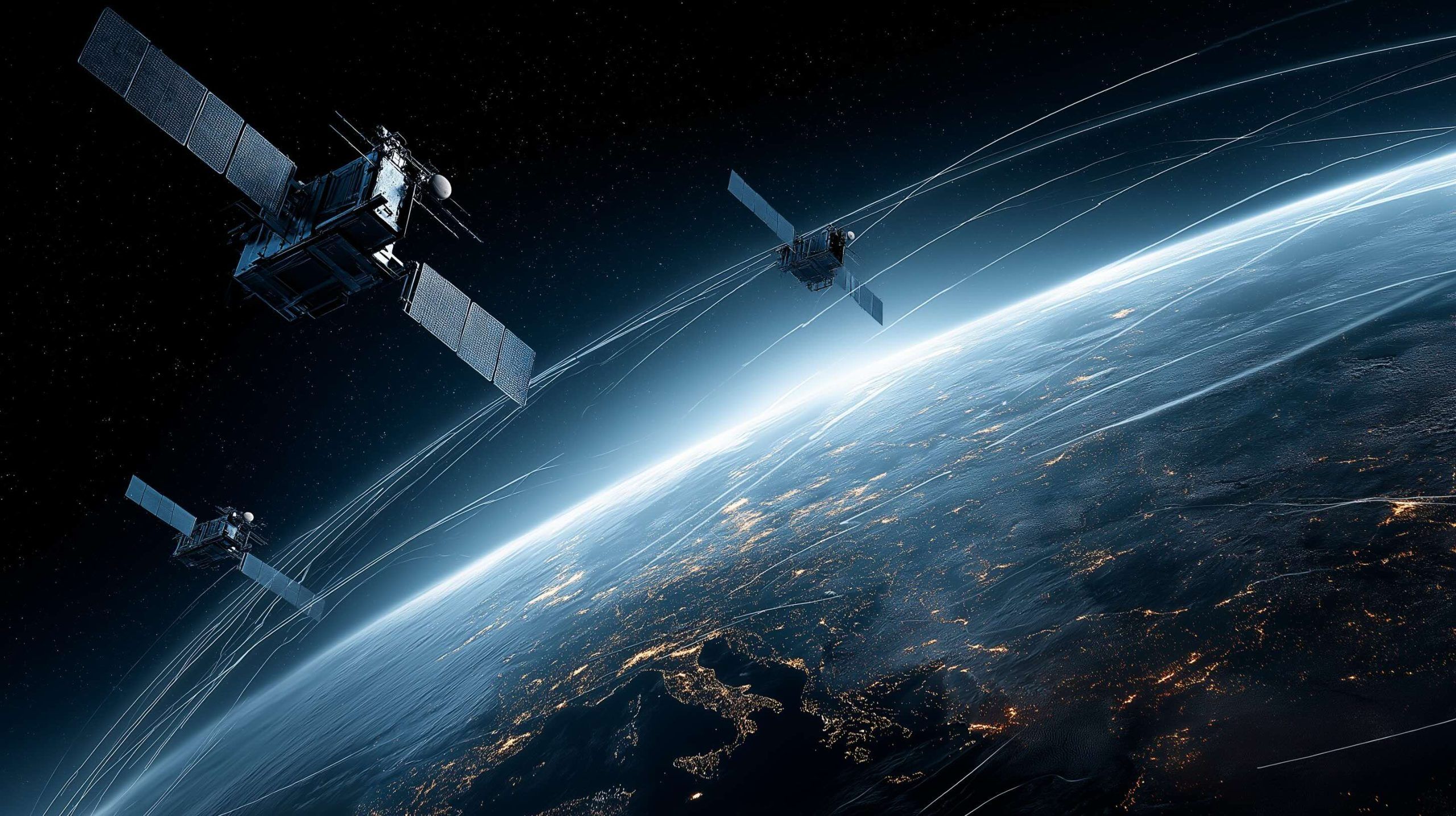- Sputnik 1, launched on October 4, 1957, was the world’s first artificial satellite.
- Sputnik 2, launched in 1957, carried Laika the dog into orbit, the first living creature in space.
- Explorer 1, launched January 31, 1958, discovered Earth’s Van Allen radiation belts, proving satellites could do serious science.
- TIROS-1, launched in 1960, was the first weather satellite, demonstrating that orbiting cameras could observe cloud patterns and improve forecasting.
- Telstar 1, launched in July 1962, became the first active communications satellite and relayed the first live television signals across the Atlantic.
- Geostationary orbit at about 35,786 km above the equator allows a satellite to hover over one spot, as shown by the 1974 GOES weather satellite.
- The Global Positioning System (GPS) began with Navstar satellites launched in 1978, reaching a full constellation by the mid-1990s and enabling meter-level global navigation.
- The Hubble Space Telescope was deployed in 1990, giving astronomers an ultra-sharp view of the cosmos and revolutionizing astronomy.
- The Landsat program began in 1972 and has provided an unbroken 50-year archive of Earth’s surface changes across successive satellites.
- SpaceX launched the Starlink megaconstellation in 2019, and by 2025 had deployed thousands of satellites with plans for up to 42,000 in orbit to provide global broadband.
Ultimate Guide to Satellites: From Sputnik to SpaceX and Beyond
Satellites are the unseen workhorses of modern life. Every time you check the weather, follow GPS directions, or watch live international events, you’re benefiting from satellites orbiting high above. But what exactly are satellites, and how did we go from the humble beginnings of Sputnik in 1957 to today’s SpaceX Starlink mega-constellations? This comprehensive guide will explore what satellites are (both natural and artificial), retrace the rich history of satellite technology, break down the different kinds of satellites and their uses, explain how these orbiting machines work, and dive into current trends shaping the future of satellites. Along the way, we’ll include insights from space agencies and experts to illuminate the past, present, and future of these “eyes in the sky.”
What Is a Satellite? (Natural vs Artificial)
In the broadest sense, a satellite is any object that orbits around a larger object. By that definition, natural satellitesinclude celestial bodies like moons and even planets – for example, Earth is a satellite of the Sun, and the Moon is a satellite of Earth [1]. Typically, though, when we talk about satellites today, we mean artificial satellites: human-made machines launched into space to orbit Earth or another celestial body [2]. These artificial satellites come in all shapes and sizes and serve a wide range of purposes, from communications and navigation to science and defense.
There are thousands of artificial satellites orbiting Earth now, operated by over 50 countries and various organizations [3]. They share the skies with countless bits of space debris and old satellite parts – everything that humans have put in orbit counts as an artificial satellite, even a stray bolt or paint chip [4] [5]. But unlike space junk, functioning satellites are carefully designed to do useful work. In the following sections, we’ll focus on these purposeful satellites – what they do, how they came to be, and why they’re so important.
From Sputnik to Starlink: A Brief History of Satellites
Sputnik and the Dawn of the Space Age (1950s–1960s): The Space Age began dramatically on October 4, 1957, when the Soviet Union launched Sputnik 1 – the world’s first artificial satellite. Sputnik was a shiny metal sphere about the size of a beach ball that circled Earth every 98 minutes, sending out beeping radio signals [6]. Its launch shocked the world and marked a major Cold War milestone, as few believed the Soviets could beat the U.S. into space [7]. Just a month later, Sputnik 2 carried the first living creature (a dog named Laika) into orbit [8]. The United States responded by launching its first satellite, Explorer 1, on January 31, 1958 [9]. Explorer 1 was small (about 13 kg) but significant – it discovered Earth’s Van Allen radiation belts, showing satellites could do serious science [10] [11].
In the early 1960s, satellite technology advanced rapidly. In 1960, NASA launched TIROS-1, the first weather satellite, which demonstrated that orbiting cameras could observe cloud patterns and improve forecasting [12]. Two years later, in July 1962, the privately-built Telstar 1 became the first active communications satellite, relaying the first live television signals across the Atlantic Ocean [13] [14]. For the first time, people in North America and Europe could watch the same live TV program via space – a stunning achievement that “sparked a new age of instant worldwide communications” [15] [16]. By the mid-1960s, the groundwork was laid for satellite communications, weather observation, and more.
Geostationary Orbits and Global Networks (1970s–1980s): Early satellites mostly flew in low or medium Earth orbits, but the 1970s saw the rise of geostationary satellites. Placed ~35,786 km above the equator, a geostationary satellite orbits at the same rate Earth rotates, so it hovers over one spot continuously [17]. This is ideal for communications and weather monitoring. In 1974, for example, the first GOES weather satellite was launched to provide constant satellite imagery of the same hemisphere. Communications networks also flourished – by the 1980s, fleets of commercial satellites like Intelsat were relaying telephone calls, television broadcasts, and data around the globe, making worldwide live broadcasts a normal part of life [18] [19].
Satellites also expanded our capabilities in navigation and science during this era. The U.S. Department of Defense began developing the Global Positioning System (GPS) in the 1970s, launching the first GPS satellites (Navstar) in 1978 [20]. By the mid-1990s, a full constellation of GPS satellites was operational, providing precise global navigation signals for military and civilian use. “Satellites have revolutionized navigation — determining where you are and where you’re going” noted a NASA overview, with GPS now pinpointing location to meter-level accuracy worldwide [21] [22]. In 1990, NASA and ESA’s Hubble Space Telescope was deployed, giving astronomers an ultra-sharp eye above the distorting atmosphere and revolutionizing our view of the universe. By the end of the 20th century, satellites had become indispensable tools for communication, science, weather forecasting, and geopositioning.
Miniaturization and New Applications (1990s–2010s): As electronics and computers shrank in size, so did satellites. In the 1990s and 2000s, smaller satellites and specialized constellations emerged. The commercial Iridium network launched 66 satellites in the late 1990s to enable satellite phone service anywhere on Earth. Remote sensing satellites like NASA’s Landsat 7 (1999) and Terra (1999) and ESA’s Envisat (2002) used improved sensors to monitor Earth’s environment in greater detail than ever, from deforestation to ocean temperature. By the 2010s, CubeSats – tiny cube-shaped satellites just 10 cm on a side – became common. Thanks to the miniaturization of sensors and affordable launch opportunities, companies and universities could deploy swarms of CubeSats for research or technology demos [23]. It’s now routine for a rocket launch to carry dozens of these pint-sized satellites alongside a primary payload. “With the miniaturization of computers and other hardware, it’s now possible to send up much smaller satellites that can do science, telecommunications or other functions in orbit,” explains Space.com, noting that companies and universities frequently populate low-Earth orbit with CubeSats today [24]. Even interplanetary probes have gotten smaller – in 2018, two briefcase-size CubeSats (Mars Cube One) accompanied NASA’s InSight lander to Mars, relaying real-time data back to Earth.
Mega-Constellations and the Modern Era (2020s and beyond): In recent years, we have entered the age of mega-constellations – massive networks of hundreds or thousands of satellites working in unison. The most prominent example is SpaceX’s Starlink project, which began launching in 2019. Starlink aims to deploy tens of thousands of small satellites in low Earth orbit to provide high-speed internet access globally [25]. As of 2025, SpaceX has deployed thousands of Starlink satellites and is already delivering broadband service to remote areas, demonstrating the potential to “bridge the digital divide” by connecting underserved regions [26]. Other companies and agencies are following suit: OneWeb has launched hundreds of satellites for its own internet constellation, and Amazon’s Project Kuiper is on the horizon with plans for over 3,000 satellites in orbit [27].
This new era comes with new challenges. The explosion in satellite numbers raises concerns about space debris and crowding in key orbits. There are already an estimated half a million artificial objects (including inactive satellites and fragments) in Earth orbit, and each new launch increases the risk of collisions [28]. Satellite operators and agencies now actively coordinate to avoid accidents – for example, SpaceX equips Starlink satellites with autonomous collision-avoidance systems that use onboard AI to dodge orbital debris [29]. Meanwhile, astronomers worry that sunlit swarms of satellites could interfere with ground-based telescopes. These issues are sparking discussions on how to keep space sustainable even as we reap the benefits of global satellite networks [30] [31].
Despite challenges, it’s clear that satellites will play an ever-growing role in coming decades. In the words of European Space Agency Director General Josef Aschbacher, “You cannot live without space in 20 years,” emphasizing that space infrastructure (especially satellites) is becoming as essential as utilities like electricity or the internet [32]. Satellites have transformed how we communicate, navigate, observe our planet, and explore the cosmos – and their evolution is far from over.
Types of Satellites and Their Uses
One way to understand the diverse world of satellites is to categorize them by who operates them and for what purpose. Broadly, we can distinguish four categories: civilian, commercial, scientific, and military satellites. (Note that these categories often overlap – for example, a single Earth observation satellite might serve civilian scientists, commercial users, and military analysts alike.) Below is a comparison of these satellite types, with examples and typical uses of each:
| Category | Examples (Notable Programs) | Primary Uses |
|---|---|---|
| Civilian (Government) | NOAA Weather Satellites (e.g. GOES series), Copernicus Sentinelsatellites (EU), INSAT (India) | Public services for civilians: weather monitoring and forecasting, environmental and climate observation, disaster tracking, and civil communications. Operated by civilian agencies (like NASA, NOAA, ESA) for the public good [33] [34]. These satellites provide data for meteorologists, map makers, agriculture, and more. |
| Commercial (Private) | Communications:Intelsat and EchoStar TV satellites; Iridium and Globalstar telecom satellites; SpaceX Starlink internet constellation. Earth Imaging:Planet Labs Dove CubeSats; Maxar high-resolution imaging satellites. | Profit-driven services: communications (TV, radio, telephone, internet), satellite broadband, and commercial Earth observation. For example, communications satellites in geostationary orbit relay international television and telephone traffic [35], while imaging satellites sell high-res photos to industries. Commercial ventures also now launch large constellations (like Starlink) to provide global internet coverage [36]. |
| Scientific (Research) | Space Telescopes: Hubble Space Telescope, James Webb Space Telescope (JWST). Planetary Probes in Orbit: Mars Reconnaissance Orbiter, Lunar Reconnaissance Orbiter. Earth Science:NASA Terra/Aqua Earth Observing System, Landsat series (NASA/USGS). | Research and exploration: these satellites carry scientific instruments (cameras, radiometers, spectrometers, etc.) to collect data for understanding our world and the universe. Astronomical satellites like Hubble and JWST observe distant stars and galaxies above Earth’s atmosphere, yielding discoveries about the cosmos. Earth science satellites monitor climate, oceans, land use, and atmospheric chemistry over long periods – e.g. the Landsat program has provided an unbroken 50-year record of Earth’s surface changes, “a magnificent achievement in the history of science” that helps track climate change [37]. |
| Military (Defense) | Reconnaissance (Spy):Keyhole/CRYSTAL electro-optical imaging sats (U.S.), Kobalt series (Russia). Signals Intelligence:NROL- series (U.S. NRO), Yaogan(China). Navigation: GPS(U.S. Air Force), GLONASS(Russian), Galileo(EU civilian/military). Early Warning:SBIRS missile-detecting sats (U.S.), OKO(Soviet/Russian). | National security and defense: military satellites gather intelligence (high-resolution imagery, radar mapping, eavesdropping on communications) and provide secure communication links for armed forces. They also enable navigation and timing (the U.S. GPS, originally military-operated, now provides free global positioning signals [38]) and detect missile launches or nuclear detonations from space. Often shrouded in secrecy, military satellites have been called “eyes in the sky” for their role in surveillance. Some, like navigation and communication satellites, serve both military and civilian users, illustrating the dual-use nature of space technology [39] [40]. |
This categorization is just one lens. Satellites can also be classified by the functions they perform (e.g. communications, Earth observation, navigation, astronomy) or by their orbital regime (e.g. low-Earth orbit vs geostationary vs deep space). But however you classify them, all satellites share the common challenge of operating in space and the common goal of extending human reach beyond Earth’s surface.
How Do Satellites Work?
Despite the variety of missions and designs, most satellites have to solve the same fundamental problems: how to stay in orbit, how to power themselves, how to communicate, and how to fulfill their specific mission (sensing, transmitting, etc.). Let’s break down some of the basics of how satellites work:
Orbital Mechanics – Staying in Orbit: Satellites stay in space by moving fast enough horizontally that as they “fall” towards Earth under gravity, the ground curves away beneath them. In practical terms, a satellite needs a minimum speed of about 8 kilometers per second (~28,000 km/h) to achieve low Earth orbit; otherwise, it would simply fall back to Earth [41]. At the right speed, it falls around Earth instead of into it. This means an orbit is essentially a controlled free-fall. The closer a satellite orbits to Earth, the faster it must go and the shorter its orbital period – for instance, a satellite in low Earth orbit (a few hundred kilometers up) might circle the globe in ~90 minutes. Satellites in higher orbits (like geostationary orbit at 35,786 km altitude) move more slowly and can even appear stationary relative to the ground [42]. A geostationary satellite takes 24 hours to orbit (matching Earth’s rotation), allowing it to “sit” over one longitude and provide continuous coverage to that area – ideal for communications and weather satellites [43]. Orbital choice is all about trade-offs: low orbits give better resolution for imaging and lower latency for communications but cover a small area and experience atmospheric drag, whereas high orbits cover huge areas and have stable views but require more powerful signals and have higher latency.
Key Components of a Satellite: Regardless of mission, almost all operational satellites have a few core subsystems. First, a power source – usually solar panels and rechargeable batteries – provides electricity to run the onboard systems [44]. (A few spacecraft, especially missions that travel far from the Sun or need lots of power, use nuclear power sources instead.) Second, an attitude control system (with components like reaction wheels, magnetorquers, thrusters, and star trackers) stabilizes and orients the satellite [45]. This is crucial: a satellite must typically point its antennas toward Earth and its sensors toward their targets (e.g. a weather satellite points its camera at Earth, a communications satellite points its dish at a ground station). Third, every satellite has communication antennas to send and receive data or commands [46]. Through radio (or sometimes laser) links, satellites relay their collected data down to Earth and get instructions from controllers. Finally, the payload refers to the mission-specific equipment [47]. For a communications satellite, the payload is usually a set of transponders – devices that receive incoming signals (TV, radio, internet data), amplify and shift them in frequency, and beam them back down to another location. For an imaging satellite, the payload might be a high-resolution camera or radar. For a science satellite like Hubble, the payload includes telescopes and detectors. In short, if you imagine a satellite as a robotic worker, the payload is its tool for the job, while the other systems are like life-support, power supply, and limbs to position the tool.
Communications and Control: Communication is the lifeline between a satellite and Earth. Satellites use radio transmitters and receivers to exchange data with a network of ground stations. Different missions use different frequency bands (L, S, X, Ku, Ka, etc.) depending on their needs. For example, GPS satellites broadcast navigation signals in L-band; weather satellites send imagery in X-band; deep-space probes phone home in X or Ka band. The data rates can range from a few bits per second (for distant space probes) to gigabits per second (for modern broadband satellites). Because of their altitude, satellites have a huge line-of-sight – a single telecom satellite in geostationary orbit can cover about a third of Earth’s surface. This is why before satellites, transmitting TV or telephone signals across the globe was so difficult: signals would disappear over the horizon or be blocked by Earth’s curvature [48]. Satellites solved that by acting as space-based repeaters – they receive signals from one point on Earth and retransmit them to another, effectively bypassing distance and terrain [49]. This made live intercontinental TV and global phone networks possible. Satellites are monitored and controlled by operations teams on the ground. Operators send up commands to tweak orientation, update onboard software, or fire thrusters, and they receive telemetry (health and status data) back. Some satellites, especially newer ones, have a degree of autonomy and onboard smarts – they can manage routine tasks or even, in some cases, avoid collisions automatically using AI algorithms [50] (more on that in the trends section).
Propulsion and Orbit Keeping: Once in orbit, a satellite continues moving due to inertia, but subtle forces can alter its path over time. Low orbit satellites experience atmospheric drag which gradually slows them and lowers their orbit, eventually causing reentry (this is why the International Space Station has to periodically boost its orbit). Satellites in all orbits can be perturbed by Earth’s non-uniform gravity, the pull of the Moon and Sun, and even pressure from sunlight. To counteract these effects or to maneuver, many satellites carry a limited supply of fuel for their small thrusters. Using tiny bursts of thrust, satellites can perform station-keeping – adjusting their orbit or orientation to stay in the correct position (for example, a geostationary satellite must fire thrusters occasionally to remain exactly above its assigned longitude) [51]. Thrusters are also used for major orbital changes, like moving a retired geostationary satellite to a higher “graveyard” orbit at end of life [52], or lowering a satellite’s orbit to speed up its reentry and disposal. In recent years, efficient electric propulsion (ion thrusters) has become common on satellites, allowing more maneuvers for the same fuel mass (though with very gentle thrust). Some modern satellites can even autonomously perform collision avoidance – each Starlink internet satellite, for instance, “independently monitors potential approaches and, when necessary, turns on its engines to dodge, without operator intervention,” executing thousands of evasive maneuvers every year [53]. Propulsion capability is a crucial factor in satellite lifespan and flexibility.
Sensors and Instruments: Finally, what a satellite does depends on its instruments. Different missions have wildly different payloads: Camera systems on observation satellites can capture everything from narrow-angle, high-res images of cities to wide-angle views of cloud systems. Weather satellites often carry radiometers that detect thermal infrared radiation to map temperatures and water vapor. Reconnaissance satellites might use synthetic aperture radar to see through clouds or take images at night. Scientific satellites might carry particle detectors to measure radiation belts, magnetometers to measure magnetic fields, or telescopes to measure light from distant stars. Whatever the sensor, satellites often need to store the collected data onboard (in onboard memory or recorders) and then transmit it during a pass over a ground station or via a relay satellite (NASA’s Tracking and Data Relay Satellite system, for example, provides near-constant communications for the ISS, Hubble, and other satellites by relaying their data through geostationary relay satellites) [54] [55]. In the early days, some spy satellites even physically returned film to Earth in small capsules! Today, virtually all data is sent digitally by radio.
In summary, a satellite is a marvel of engineering that balances the physics of orbit, the constraints of power and temperature in space, and the demands of sophisticated electronics – all to accomplish tasks that can’t be done from the ground. As technology has matured, satellites have become more reliable and capable, to the point that we rarely think about the incredible chain of events (launch, orbit insertion, operations) that put, say, that live sports broadcast or GPS signal above our heads.
Current Trends and Future Directions in Satellite Technology
Satellites are not static inventions – the field is evolving rapidly. New applications and technological innovations are driving a renaissance in satellite technology. Here are some of the most significant current and emerging trends:
Satellite Internet Mega-Constellations
In the past, satellite internet was often slow, expensive, and limited to a few large geostationary satellites serving broad regions. This is changing dramatically with the rise of mega-constellations in low Earth orbit aimed at providing global broadband coverage. SpaceX’s Starlink is the poster child of this movement: since 2019 SpaceX has launched thousands of Starlink satellites, with plans for a network of up to 42,000 in the coming years. These satellites operate in fleets at a few hundred kilometers altitude and work together to blanket the planet in internet connectivity. The goal is to deliver fast, low-latency internet to anywhere – from rural villages to ships at sea – essentially “building a network of low Earth orbit satellites to provide fast, reliable internet worldwide,” as one description puts it [56]. Early results are promising: Starlink users can already stream video or join video calls from places with no terrestrial broadband. Other companies and countries are racing to deploy their own constellations: OneWeb, backed by European and other investors, is launching around 600 LEO satellites for global internet (especially targeting businesses, governments, and remote communities). Amazon’s Project Kuiper expects to launch over 3,000 satellites for broadband, starting in 2024 [57]. China has proposed its own mega-constellation (Guowang), and new ideas keep emerging (from satellite IoT networks for connecting sensors, to even orbiting data centers). These swarms of satellites require advances in autonomous operation and agile manufacturing – SpaceX, for instance, mass-produces Starlinks and launches them in batches of 50+ on its Falcon 9 rockets. The mega-constellation boom also demands new management of orbital traffic: satellites must frequently adjust to avoid each other and debris. Space agencies worldwide are working on improved space traffic management to ensure all these new satellites can coexist safely. If successful, satellite mega-constellations could effectively erase the digital divide, bringing high-speed connectivity to every corner of the globe. As SpaceX’s founder Elon Musk quipped, the vision is to ensure that “someone stranding on a remote island could still watch high-definition movies” via Starlink – a far cry from the early days of Sputnik’s simple beeps.
Earth Observation and Climate Monitoring from Space
Satellites have revolutionized how we monitor our planet. Today, fleets of Earth observation satellites operated by agencies like NASA, NOAA, ESA, and private companies continuously scan the Earth’s land, oceans, and atmosphere in myriad ways. This trend is accelerating, with an emphasis on climate change monitoring and environmental management. For example, the European Union’s Copernicus program (with Sentinel satellites) provides free, up-to-date data on everything from Arctic sea ice to air pollution. NASA and USGS’s Landsat 8 and 9 satellites continue a series dating back to 1972, creating an invaluable 50-year archive of Earth’s surface changes. “For more than fifty years now, Landsat satellites have helped us learn more about how Earth systems work, how human activities affect those systems, and how we can make better decisions for the future,” said NASA Administrator Bill Nelson in 2022 [58], highlighting the critical role of satellites in understanding climate change.
Many newer satellites are focusing on specific climate-related variables: NASA’s OCO-2 and ESA’s CarbonSat track carbon dioxide levels; satellites like GRACE-FO measure ice sheet losses by gravitational changes; SMAP monitors soil moisture; weather satellite upgrades (GOES-R series, MetOp) improve hurricane and storm forecasting with better sensors. There is also a trend toward open data and shared constellations for climate – for instance, Copernicus Sentinel-6 (a NASA/ESA collaboration launched 2020) measures sea level rise with unprecedented precision to inform climate policy [59] [60]. Importantly, the data volume is exploding – and so is the need to analyze it. That’s where another trend comes in (discussed below): using AI to sift through massive Earth observation datasets quickly and even process data on the satellite itself. Overall, satellites are the backbone of climate science: they provide the unbiased global coverage needed to see planetary trends. From spotting illegal deforestation to measuring the heat content of the oceans, satellites give us the big picture needed to tackle global challenges. As one NOAA slogan puts it, “to understand and protect the Earth, you have to see it” – and satellites are our eyes.
CubeSats and SmallSats: Space for Everyone
The democratization of space is well underway thanks to the rise of CubeSats and other small satellites. CubeSats, standardized small satellites often 10x10x10 cm in size (1 “U”) or a few “U” in volume, have lowered the cost and barrier to entry for space missions. Universities, startups, and even high schools have built CubeSats that piggyback to orbit on larger launches. What began as educational experiments have evolved into serious endeavors – today CubeSat swarms can carry out tasks like daily imaging of Earth (Planet Labs operates over 100 Dove CubeSats that image the entire Earth landmass each day), radio occultation for weather (Spire Global’s CubeSats gather GPS signal distortions to infer atmospheric data), and technology demonstrations (testing new microprocessors or sensors in space). Small satellites can be built and launched for a few hundred thousand dollars, compared to multimillions for traditional large sats. This has opened the door for many countries and small companies to have a presence in orbit.
SmallSats are also helping national agencies do more with less. For instance, NASA’s Cyclone Global Navigation Satellite System (CYGNSS) uses eight mini-satellites to measure ocean surface winds and improve hurricane forecasting at lower cost than a single large satellite. Another example: the two briefcase-sized MarCO CubeSats that flew to Mars in 2018 successfully relayed telemetry from the InSight lander back to Earth, proving that tiny satellites can play a role even in deep-space exploration. The trend now is toward constellations of small satellites working in concert – much like a distributed system in space. These can provide resilience (if one fails, others fill in) and regular coverage (many points of observation or communication across the globe). Of course, small satellites have limitations: they typically have shorter lifespans, less power, and less capability than big ones. But their low cost and rapid development (often <2 years from design to orbit) means they can incorporate the latest tech and be refreshed frequently. We can expect to see more innovative uses of CubeSats, from swarms that detect ships or aircraft (for tracking logistics globally) to perhaps networks of science stations around the Moon or Mars. Space is no longer the realm of only superpowers and large corporations – small satellites have made it accessible to startups, students, and developing nations, injecting a burst of creativity and entrepreneurship into the satellite industry.
AI and Autonomous Satellites
Artificial intelligence is finding its way into space, promising to make satellites smarter and more autonomous. Traditionally, satellites have been largely reliant on ground control for decision-making – for example, deciding which images to take or when to perform maneuvers. But with hundreds or thousands of satellites in some constellations and the need for real-time responsiveness, onboard AI is increasingly attractive. One area AI is transforming is image processing and disaster response. Instead of downlinking all raw images for humans to examine, satellites can use computer vision onboard to detect events and only send down the important alerts. NASA’s Jet Propulsion Laboratory, for instance, has tested an AI system called Dynamic Targeting on a small satellite (CogniSAT-6) that allows the satellite to analyze images in orbit and prioritize ones showing, say, flood regions or wildfire smoke [61] [62]. In a 2023 pilot during a wildfire in California, the AI-powered satellite identified smoke plumes and immediately transmitted that information to firefighters on the ground, cutting down a process that normally takes hours or days to mere minutes [63] [64]. “We’re at an inflection point. Satellites will no longer just observe; they’ll analyze, interpret, and respond in real time,” says Fintan Buckley, CEO of Ubotica (NASA’s partner on the project) [65].
Another critical application of AI is autonomous navigation and collision avoidance. With so many objects in orbit, automating avoidance maneuvers is key to safety. SpaceX’s Starlink satellites use an AI-driven system to continuously assess collision risks using U.S. Space Force tracking data; each satellite can autonomously adjust its orbit to avoid a predicted close approach [66]. According to SpaceX, the Starlink fleet was performing on the order of 50,000 collision avoidance maneuvers every six months – something that simply couldn’t be managed via manual control for each satellite [67]. AI also enables formation flying – multiple satellites keeping tight coordination. An example is the upcoming Proba-3 mission by ESA, where two spacecraft will fly in formation to form a giant coronagraph (one acting as an occulter, the other as observer). This requires precise autonomous control, which AI can assist by processing sensor data and adjusting positions in real time.
AI is further being applied to satellite health monitoring (spotting anomalies in telemetry that humans might miss) and dynamic spectrum management (optimizing frequencies and bandwidth usage on the fly). NOAA has implemented an AI system for its GOES weather satellites that monitors hundreds of telemetry parameters and can flag potential issues faster than human operators [68]. All these trends point toward a future where satellites increasingly think for themselves. This will be crucial especially for deep-space missions (where communications delays make Earth-command impractical) and large constellations (where decisions need to be made locally and quickly). There are, of course, considerations about trusting AI in critical space systems – one can imagine scenarios of false alarms or unexpected behaviors. Rigorous testing and incremental adoption are underway to build confidence. But most experts agree that autonomy is the only way to manage the exponentially growing complexity of space operations. In essence, satellites are turning into AI-powered robots in orbit, capable of reacting and adapting to their environment without waiting for instructions from Earth.
Beyond Earth: Interplanetary and Future Concepts
While this guide focuses on Earth-orbiting satellites, it’s worth noting that we are also populating other orbits in the solar system with artificial satellites. Mars has an entire fleet of orbiters from NASA, ESA, India, and others, acting as satellites of Mars to study the planet and relay data from rovers. Venus, Jupiter, and Saturn have all had orbiters (e.g. Magellan at Venus, Juno at Jupiter, Cassini at Saturn) – essentially artificial satellites of those worlds during their mission lifetimes [69]. Even small bodies like asteroids have been orbited by probes (Japan’s Hayabusa2 orbited asteroid Ryugu; NASA’s OSIRIS-REx orbited asteroid Bennu). In the coming years, we plan to create a lunar satellite network (the Lunar Gateway space station will orbit the Moon, and NASA’s CAPSTONE CubeSat is already testing a new halo orbit around the Moon). These developments blur the line between “satellite” and “spacecraft,” but fundamentally they are the same concept – orbiting objects performing useful tasks. As human activity extends to the Moon and beyond, satellites around other bodies will likely provide communications, navigation (imagine a “GPS” around the Moon), and science data just as they do at Earth.
Looking further ahead, concepts like satellite servicing and recycling are emerging. Future satellites may be designed to be refueled or repaired by robotic service satellites, extending their lifespans and reducing space junk. Experimental missions like Northrop Grumman’s MEV (Mission Extension Vehicle) have already docked with aging satellites to provide life-extending boosts. Other proposals include manufacturing satellites in orbit (to avoid launch size limits) and even space-based solar power satellites that would collect solar energy and beam it to Earth – a concept under study by multiple agencies. The common theme is that satellites are becoming more integrated into the human ecosystem, not just passive machines we launch and forget. They’re becoming smarter, more numerous, more collaborative, and even interplanetary.
Conclusion
From the silvery beeps of Sputnik circling a tense Cold-War Earth, to the invisible threads of connectivity provided by today’s satellite constellations, the journey of satellite technology has been nothing short of extraordinary. In just over six decades, we’ve gone from zero satellites to a world where satellites are indispensable infrastructure – as critical to the modern world as electricity, transportation, or the internet. They connect the far corners of the globe, help us understand and protect our planet, underpin national security, enable explorers to probe the solar system, and even give us perspective on our place in the universe.
As we move forward, satellites will only grow in importance. They will likely fade further into the background of our lives (few people think about the constellation of GPS satellites when navigating their car, or the communications satellites when making a transoceanic video call), yet humanity’s dependence on the space above will deepen. In the words of one space leader, the goal is to make space so useful that in a couple of decades “you cannot live without space”– meaning without the services satellites provide [70]. Achieving that means overcoming challenges like orbital crowding, developing new technologies like autonomous operations and on-orbit servicing, and ensuring sustainable use of space for generations to come.
Satellites are a shining example of turning science fiction into reality. The next time you get a weather alert, follow your maps app, or watch a live sports match from another continent, take a moment to appreciate the ultimate high-ground vantage that makes it possible. Above us, the satellite fleet – from small CubeSats to enormous space telescopes – is hard at work, a testament to human ingenuity above and beyond.
Sources: This guide drew on information from reputable sources including NASA and NOAA (for definitions and historical data), ESA and space agency publications, academic and scientific outlets, and major science media like Space.com and Scientific American. Notable references and quotes were taken from NASA’s official releases and statements (e.g. NASA Administrator’s remarks on Landsat [71]), ESA interviews [72], and expert commentary on emerging satellite technology [73] [74]. These sources are cited throughout the text via the numbered references, to encourage readers to explore further and verify the details in context. The story of satellites is a rich and ongoing one – truly a “ultimate guide” topic that spans Earth and beyond. Here’s to the next chapter in the satellite saga, wherever it may orbit!
References
1. www.nasa.gov, 2. www.nasa.gov, 3. www.nesdis.noaa.gov, 4. www.space.com, 5. www.space.com, 6. www.space.com, 7. www.space.com, 8. www.space.com, 9. www.space.com, 10. www.space.com, 11. www.space.com, 12. visionsforeurope.eu, 13. visionsforeurope.eu, 14. spacecenter.org, 15. spacecenter.org, 16. spacecenter.org, 17. www.space.com, 18. www.space.com, 19. www.space.com, 20. www.nasa.gov, 21. www.nasa.gov, 22. www.faa.gov, 23. www.space.com, 24. www.space.com, 25. visionsforeurope.eu, 26. visionsforeurope.eu, 27. www.scientificamerican.com, 28. www.space.com, 29. www.intersputnik.int, 30. www.space.com, 31. www.scientificamerican.com, 32. www.euronews.com, 33. www.nesdis.noaa.gov, 34. www.space.com, 35. www.space.com, 36. visionsforeurope.eu, 37. www.nasa.gov, 38. www.nasa.gov, 39. spacegeneration.org, 40. www.nasa.gov, 41. www.space.com, 42. www.space.com, 43. www.space.com, 44. www.space.com, 45. www.space.com, 46. www.space.com, 47. www.space.com, 48. www.nasa.gov, 49. www.nasa.gov, 50. www.intersputnik.int, 51. www.space.com, 52. www.space.com, 53. www.intersputnik.int, 54. www.nasa.gov, 55. www.nasa.gov, 56. visionsforeurope.eu, 57. www.scientificamerican.com, 58. www.nasa.gov, 59. www.nasa.gov, 60. www.nasa.gov, 61. www.fastcompany.com, 62. www.fastcompany.com, 63. www.fastcompany.com, 64. www.fastcompany.com, 65. www.fastcompany.com, 66. www.intersputnik.int, 67. www.intersputnik.int, 68. www.intersputnik.int, 69. www.space.com, 70. www.euronews.com, 71. www.nasa.gov, 72. www.euronews.com, 73. www.fastcompany.com, 74. www.intersputnik.int









